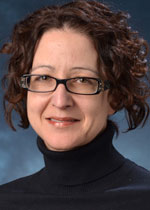57th Annual Report on Research 2012 Under Sponsorship of the ACS Petroleum Research Fund
Dr. Christine M. Hrenya
 Department of Chemical and Biological Engineering
Department of Chemical and Biological Engineering
University of Colorado, Boulder
Toward the Quantitative Prediction of Instabilities in Solids Flows
Anyone sitting on a beach has observed granular flow, as sand grains are moved by beach winds. Downwind settling of volcanic ash particles after an eruption is another example of particulate flows. Research on particle flows, performed by Dr. Christine Hrenya, Professor of Chemical Engineering at the University of Colorado at Boulder, has been supported by the ACS Petroleum Research Fund. Her most recent project has received an ACS PRF New Directions grant for investigations into instabilities in granular flows.
Mathematical simulations using kinetic theory-based models resemble closely the experimental images of clustering instabilities - dense collections of particles which continuously form and dissolve. Hrenya's ACS PRF proposal was to test the quantitative accuracy of these models. She says,"We know the pictures we've gotten to date, and they match very well with what we have seen experimentally, but quantitatively, we haven't tested how good these models are."
Applications of flow instability research include design of multi-phase reactors, in which a gas phase interacts with solid particles. Fluid catalytic crackers (FCCs) are multi-phase reactors that break down crude oil into fuel and other usable hydrocarbons, by interaction between solid catalysts and gas-phase reactants. These reactors require good gas-solid contacting for efficient operation, but if particles segregate or just clump, the reaction may have lower yields. Research leading to improved efficiency of FCC processes, and thus more efficient petroleum refining, would provide tremendous economic benefits to refiners and to consumers, in the form of cheaper gas.
Upon looking at discrete-particle simulations of gas-solid flows, Hrenya's team noticed that more dissipative particles initially lose energy faster, but once an instability develops they lose energy at a much slower rate. As a result, more dissipative flows can have a higher level of kinetic energy in un-driven systems at longer times. It is this type of "ideal" simulation data that can be used as a stringent, quantitative test of theory. According to Hrenya, "What excites me most about our research is the potential to quantitatively validate theoretical models so that instabilities can be predicted accurately… and that is the key to making them industrially relevant." While there is still much to learn about FCC processes and there are still opportunities for further research, Hrenya feels that having more accurate models will help in the design and continued optimization in scale of these reactors.
"This New Directions grant allowed my group to get involved in work which was inspired by what I'd seen in the fluid mechanics literature," says Hrenya. Furthermore, "The results we obtained using our ACS PRF grant have since been used as preliminary results in grant proposals to both the Department of Energy and the National Science Foundation, and those proposals have been successful." She looks forward to future projects, "We already have funding to continue this research in a more complex system where additional dissipative mechanisms for instability formation are present."
Grant 50885-ND9: Read Hrenya's Annual Report
Banner source image credit: http://hvo.wr.usgs.gov/multimedia/archive/2008/Mar/20080331_2261_KMW_L.jpg










